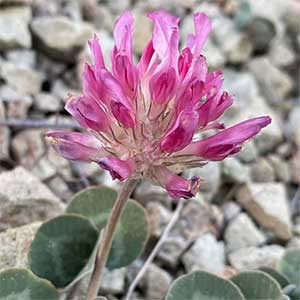Trifolium owyheense
Trifolium stoloniferum
Owyhee clover
running buffalo clover
cespitose, spreading, branched proximally, sparsely branched distally.
creeping, branched, rooting at nodes.
palmate;
stipules broadly obovate, 1–2 cm, fused at base, margins slightly lobed, apex acute;
petiole 2–6 cm;
petiolules 1–1.5 mm;
leaflets 3, blades ovate, obovate, or orbiculate, slightly overlapping, 1–2 × 0.7–2.3 cm, base truncate to rounded, veins prominent, margins sparsely dentate, apex rounded, emarginate, surfaces glabrous.
palmate, opposite or subopposite on erect stems;
stipules lanceolate (on prostrate stems) or ovate (on erect stems), 1–2 cm, margins entire or shallowly serrate, apex acuminate;
petioles 6–15 cm on prostrate stems, 0.5–4 cm on erect stems;
petiolules 1 mm;
leaflets 3, blades broadly ovate or obcordate, 1–2 × 0.5–2.5 cm, base broadly cuneate to rounded, veins fine, margins serrate, apex emarginate or rounded, surfaces glabrous.
terminal, 20–30-flowered, globose, usually formed of 2 sessile heads, 2.5–5 × 2.5–5 cm;
involucres absent.
terminal, single or paired at tip of upright stem, 15–30-flowered, globose, 2–3.5 × 2–3.5 cm;
involucres absent.
3–7 cm, surpassing subtending leaves.
2–7 cm.
erect, reflexed in proximalmost flowers, 1 mm;
bracteoles cuplike, 0.5 mm.
elongated and strongly reflexed in fruit, 2–5 mm;
bracteoles lanceolate, 2 mm.
15–21 mm;
calyx tubular-campanulate, 9–12 mm, pilose, veins 10, tube 4.5–6 mm, lobes subequal, abaxialmost longest, subulate, orifice open;
corolla deep pink or magenta, 20–23 mm, banner tubular for most their length, 18–22 × 5–7 mm, apex flared.
9–15 mm;
calyx campanulate, 4–7 mm, glabrous or sparsely pubescent, veins 10, tube 1.3–3.3 mm, lobes subequal, subulate, orifice open;
corolla white, veins often pinkish, 8–14 mm, banner ovate or oblong, 8–14 × 4–5 mm, apex rounded or emarginate.
ellipsoid, 4–5 mm.
oblong, 2.5–3 mm.
1 or 2, yellow-mottled, mitten-shaped, 2–3 mm, smooth.
1 or 2, tan to brown, reniform, 1.3–2 mm, smooth.
= 16.
Trifolium owyheense
Trifolium stoloniferum
Trifolium owyheense is known from about 40 populations in a small portion of east-central Malheur County in Oregon, and immediately adjacent Owyhee County in Idaho (M. Mancuso 2001).
(Discussion copyrighted by Flora of North America; reprinted with permission.)
Trifolium stoloniferum was thought to be extinct but was rediscovered in the early 1980s (R. L. Bartgis 1985). It is now known from extant populations scattered throughout much of its original range, in five of the original eight states in which it was found historically (D. J. Crawford et al. 1998); it was discovered in Greene County, Pennsylvania, in 2017, but appears to be extirpated in Arkansas, Illinois, and Kansas. R. J. Hickey et al. (1991) examined genetic diversity of T. stoloniferum populations using allozymes and found low diversity, with some populations appearing genetically uniform. Molecular studies using RAPDs (Crawford et al.) indicated somewhat higher genetic diversity, even in relatively small populations.
Trifolium stoloniferum is in the Center for Plant Conservation’s National Collection of Endangered Plants.
(Discussion copyrighted by Flora of North America; reprinted with permission.)


